Spanish playing cards
Spanish cards from 1574.
Naipes Españoles or Cartas Españolas (literally "Spanish cards") are playing cards associated with Spain. The deck is also called Baraja Española (literally Spanish Deck). It has four suits and is usually made up of 40 or 48 cards. It is categorized as a Latin deck and has strong similarities with the Italian deck and less to the French deck. Spanish suited cards are widely used in Spain, southern Italy, parts of France, Hispanic America, North Africa and the Philippines. Baraja in the Spanish language can refer to any type of card deck.
Description
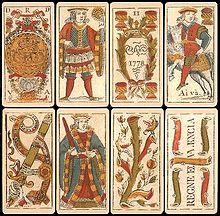
Spanish deck printed in Valencia in 1778.
The traditional Spanish baraja is an old deck that was brought over by the Moors to Spain during the 14th century. The cards are still called naipes after the nā'ib cards found in the Mamluk deck. The suits closely resemble those of northern Italian cards and Italian tarot decks. In fact, the Baraja, like the tarot, are used for both game playing and cartomancy. The Baraja have been widely considered to be part of the occult in many Latin-American countries, yet they continue to be used widely for card games and gambling, especially in Spain. Among other places, the Baraja have appeared in One Hundred Years of Solitude and other Spanish and Latin American literature (e.g., Viaje a la Alcarria by Camilo José Cela). Almost every Spanish family has at least one Baraja.
Cards and suits
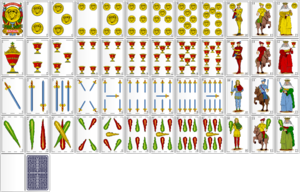
GNU themed Spanish deck of 48 cards. Note
la pinta around the edges.
48-card decks have nine ranks of pip cards (1-9) and three ranks of face cards (10-12). They are usually sold with two comodines (Jokers) for a total of 50 cards. Smaller decks have 40 cards and lack ranks 8, 9 and comodines. The four suits are bastos (clubs), oros (literally "golds", that is, golden coins), copas (cups) and espadas (swords). The four suits are thought to represent the four social classes of the Middle Ages. The suit of coins represents the merchants, the clubs represents the peasants, the cups represent the church and the swords represent the military. Unlike the suits found in northern Italy, Spanish swords are straight and the clubs resemble knobbly cudgels instead of ceremonial batons. Swords and clubs also don't intersect (except in the 3 of clubs card).
The three face cards of each suit have pictures similar to the jack, queen, and king in the French deck, and rank identically. They are the sota, which is similar to the jack/knave and generally depicts a page or squire, the caballo (knight, literally "horse"), and the rey (king) respectively. Reversible face cards exist but are not popular.
There are instances of historical decks having both caballo and reina (queen), the caballo being of lower value than queen. These decks have no numbers in the figure values, not even letters as in the French deck.
Each card has an outline frame to distinguish the suit without showing all of your cards: The cups have one interruption, the swords two, the clubs three, and the gold none. This mark is called "la pinta" and gave rise to the expression: le conocí por la pinta ("I knew him by his markings"). La pinta first appeared around the mid-17th century.
It is also possible to find 52-card French decks with Spanish pictures. These have English corner indices which means the Knight will have the Queen's "Q" index.
Extinct Portuguese pattern

Unsun
karuta set. Note the dragon like Aces (far right) characteristic of Portuguese decks.
Latin-suited cards (with cups, swords, coins and sticks like in Spain) were also used in Portugal during the Middle Ages and Renaissance periods, until the late 19th and early 20th centuries when these cards were abandoned in favour of the French deck. Popular games like Arrenegada (Portuguese name for Ombre), Bisca (Portuguese name for briscola) and Sueca, which were played with Latin-suited cards, had to be adapted to the new French-suited cards. Thus:
- the old suit names were attributed to the new suits - this is the reason why Portuguese names for suits don't match the suit drawings. In Portuguese, the Hearts suit is called Copas ("cups"), the Spades suit is called Espadas ("swords"), the Diamonds suit is called Ouros ("gold coins"), and the Clubs suit is called Paus ("clubs" or "sticks").
- the new face cards (King, Queen, Jack) had also to match the old ones (King, Knight, Knave). The King match was an obvious one, but the Queen was held for the lower court card because the old Portuguese sotas were female, and so it was matched with the Knave. The Jack was thought to be the Knight (Cavalier). Thus, in traditional Portuguese games, the cards usually rank King-Jack-Queen.
The extinct Portuguese deck featured straight swords and knobbly clubs like the Spanish suits but intersected them like the northern Italian suits. The Aces featured dragons, the kings were seated, and the knaves were all distinctly female. The closest living relative of the Portuguese deck is the Sicilian Tarot which has these features minus the Aces. The extinct Minchiate deck also shared some features. This system was believed to have originated in Spain. The Spanish spread it to Portugal, southern Italy, Malta, and as far as Peru but it died out in its homeland. During the 18th-century, the Portuguese, but not Sicilian Tarot kings, started standing like their Spanish counterparts. Another difference between the Portuguese and "Italo-Portuguese" patterns was that the Portuguese decks lacked rank 10 pip cards like the Spanish patterns while "Italo-Portuguese" decks have them like northern Italian patterns.
The Portuguese spread their cards to Brazil and Java where they were also abandoned in favor of the French deck. Portuguese decks also started the development of karuta in Japan though they bear little resemblance to their ancestor.
Current standard patterns
Standard patterns are card designs in the public domain that have been printed by multiple publishers in the past or present. These are regional patterns that are still in use today. Decks with 50 cards have two jokers.
Castilian
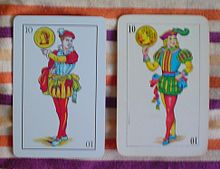
Knave of coins, Castilian (left) and Mexican (right)
The Castilian pattern is the most widespread pattern in Spain. It was designed and published by Heraclio Fournier in 1889 and by the early 20th century had displaced the older patterns in Spain. Despite being called Castilian, the cards were first produced in Fournier's headquarters in Vitoria-Gasteiz, the capital of the Basque Country. Fournier made some noticeable innovations to Spanish cards such as giving the kings beards, adding faces to the coins, dagger-like swords, and red cups. Decks come in packs of 40 or 50 cards.
The Mexican pattern was derived from the Castilian in 1923 by Clemente Jacques. The knights wear wide brim hats but its most notable feature is the conversion of all the knaves to females. They come in decks of 40 cards but 50 card decks were once produced.
Spanish National pattern
The Spanish National pattern is a pattern that was most widespread in Spain before being displaced by the Castilian pattern. It is currently found in North Africa, especially in Morocco and Algeria, and Ecuador. Kings wear long robes that go all the way down to la pinta. Usually, the knave of coins features a goat (originally a dog) tethered to a pole in the background like in the Parisian Spanish pattern. Sometimes the knight of cups has the archaic inscription "AHI VA" printed on it. They are found in decks of 40 or 48 cards.

Catalan pattern kings
The Catalan pattern is the second most widespread pattern in Spain and is very common in Hispanic America. It is also called the Modern Spanish Catalan pattern to avoid confusion with similarly named patterns. The most distinguishing feature is the shape of the cups which now resemble yellow and green egg cups. Kings' robes are parted to expose their calves. They come in decks of 40 or 50 cards.
The Cádiz or Andalusian pattern is now found in the Philippines and parts of Hispanic America. Like the Catalan pattern it too was derived from the Spanish National pattern. It uses the old golden chalice of the Spanish National pattern and the knight of cups has the archaic inscription "AHI VA" printed on it. Kings wear long robes that expose their feet. They are found in decks of 40 or 50 cards.
Franco-Spanish patterns
The French Catalan pattern also emerged from the Spanish National pattern. It kept the original shape of the golden cups but added beards to the kings. Kings wear long robes that completely obscure their legs and feet. As of 2015, Ducale, a subsidiary of Cartamundi's France Cartes, is the only producer of this pattern. They sell them in decks of 48 cards, that is, no jokers.
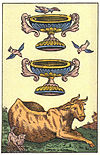
Aluette Two of Cups
Aluette is a game played in Brittany and the Vendée that comes with its own Spanish suited deck. It retains many archaic features that are no longer found in most patterns like a six-pointed star on the Four of Coins or the Catholic Monarchs kissing on the Five of Coins. The clubs feature small arrow symbols and the knights are androgynous. The Ace of Coins has a large eagle like many Italo-Spanish decks. It comes in decks of 48 cards and lacks la pinta and numeric indices. As of 2015, Grimaud, another subsidiary of Cartamundi's France Cartes, is the only manufacturer of this deck. Since 1998, Grimaud has added game hierarchy indices because the Aluette game doesn't rely on the face value of the cards.
The Parisian Spanish or Estilo Paris pattern is found in parts of South America, especially in Uruguay, Ecuador, and Colombia. It originated as a Spanish export to France which was in turn copied by Parisian card-makers and exported to South America. It contains many influences of Aluette. In the oldest decks, female knights were featured. The three lowest club cards also have Aluette styled arrows. A hand is holding the Ace of Clubs in a manner reminiscent of the Tarot de Marseille. Sometimes, the four of coins depict a sea monster in the middle like some Spanish National decks. The knave of coins features a dog tied to a pole. They are sold in decks of 40 or 50 cards.
Italo-Spanish patterns
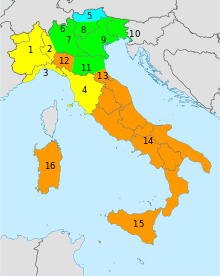
Diffusion of Spanish suited cards (orange) in Italy
Spain had a long influence over Southern Italy which reflects on the playing cards found in the former Kingdom of the Two Sicilies and the Papal States. Cards from these regions are invariably found in decks of 40 cards only and lack la pinta. Only the Sardinian pattern includes numeric indices.
Sardinian
Originally known as the Roxas pattern, the Sardinian pattern was designed by José Martinez de Castro in Madrid for Clemente Roxas in the early 19th century. It became popular in Sardinia where it has been adopted as the local standard. The most notable feature are the scenes found in the fours of each suit. The coins also feature faces like the Castilian pattern. The 3 of Clubs don't have intersecting pips.
Neapolitan and Sicilian
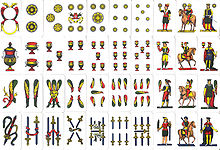
Neapolitan deck
These two interrelated patterns were created during the Kingdom of the Two Sicilies. Depending on the manufacturer, the knaves may be female. These decks are also small, only slightly larger than the average Patience sized deck.
The Neapolitan pattern is the most widespread pattern in Italy. The Ace of Coins features a double-headed eagle and the Three of Clubs has a grotesque mask. The Neapolitan pattern is also produced in Argentina, which has a large diaspora population. The Argentine version contains 50 cards and la pinta.
Sicilian pattern cards are also found in other parts of southern Italy where some players prefer them over the Neapolitan pattern. The Ace of Coins has a single-headed eagle. The 2s and 3s of the long suits intersect each other instead of just the 3 of Clubs. Many cards have small pictures to fill up the gaps between pips.
Piacentine
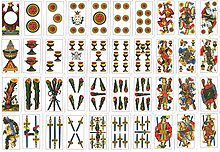
Piacentine deck
The Piacentine pattern is the northernmost of the Spanish suited patterns and along with the Neapolitan, one of the most popular. It is also the only pattern that is regularly sold with reversible face cards. Piacenza was ruled by Spanish Bourbons like the Two Sicilies but the reason that the region has uses Spanish suits is because French occupying forces brought Aluette decks. The earliest Piacentine cards were very similar to Aluette ones but developed into its current appearance by the late 19th century before becoming reversible by the mid-20th century. The Ace of Coins has an eagle similar to Aluette and Sicilian decks while the Ace of Swords is held by a cherub.
Romagnole
Located at the northern edge of the Papal States and San Marino, the Romagnole pattern is a hybrid of the Neapolitan and Piacentine patterns. Its Ace of Coins is very bare, there is neither coin nor eagle like in the other patterns. Its aces of cups and swords resemble Piacentine ones.
Tarocco Siciliano
The 64-card Tarocco Siciliano is the only tarot pattern with Spanish pips and the last living example of the Italo-Portuguese patterns. All plain suits contain ranks 5 to 10 making it the only pattern with a rank 10 that isn't a face card. The suit of coins also contains a 4 and an Ace, which has an eagle, but the Ace's purpose was to bear the stamp duty and is used in only one version of the game. All the long suit pips intersect each other and instead of using corner indices or la pinta, it uses centered indices with a single letter abbreviation of the suit. All the knaves are female and since tarot decks also include queens, this is the only pattern to have two ranks of females to survive to the present. All the kings and queens are seated. The trump suit contains 21 trumps numbered 1 to 20 with the lowest trump being unnumbered. The Fool is nicknamed the Fugitive. As of 2015, Modiano is the only producer of this deck. They are the same size as Neapolitan or the standard Sicilian decks.
Games
The Baraja is used to play several games.
Examples for 40-card decks are:
- Mus, a very popular and highly regarded vying game
- Pocha, a variation of Oh Hell
- Brisca, a trick-taking game of Italian origin, very popular in Spain, Portugal, Puerto Rico, and Dominican Republic.
- Tute, a trick-taking game with many variations
- Escoba del quince, a trick-taking game
- Julepe
- Cinquillo
- Siete y media, very similar to blackjack
- Mona
- Truc (or truco)
- Cuarenta, a fishing game, the national card game of Ecuador
- Ombre, the classic game that introduced the concept of bidding
- Conquian, earliest Western rummy game
- Ronda, a Moroccan fishing game
48-card deck games:
- Aluette
- Botiffara
- Manilla (Spanish version)
- Chinchón, can be played with a 40 or 48-card pack with or without comodines.
Cuajo is a rummy-like from the Philippines played with four copies of the Ace, 3, 4, 5, and the face cards of each suit for a total of 112 cards. It is an adaptation of the Four Color Cards Chinese game.
Read more:
COMMENTS








 Spanish deck printed in Valencia in 1778.
Spanish deck printed in Valencia in 1778. GNU themed Spanish deck of 48 cards. Note la pinta around the edges.
GNU themed Spanish deck of 48 cards. Note la pinta around the edges. Unsun
Unsun  Knave of coins, Castilian (left) and Mexican (right)
Knave of coins, Castilian (left) and Mexican (right) Catalan pattern kings
Catalan pattern kings Aluette Two of Cups
Aluette Two of Cups Diffusion of Spanish suited cards (orange) in Italy
Diffusion of Spanish suited cards (orange) in Italy Neapolitan deck
Neapolitan deck Piacentine deck
Piacentine deck